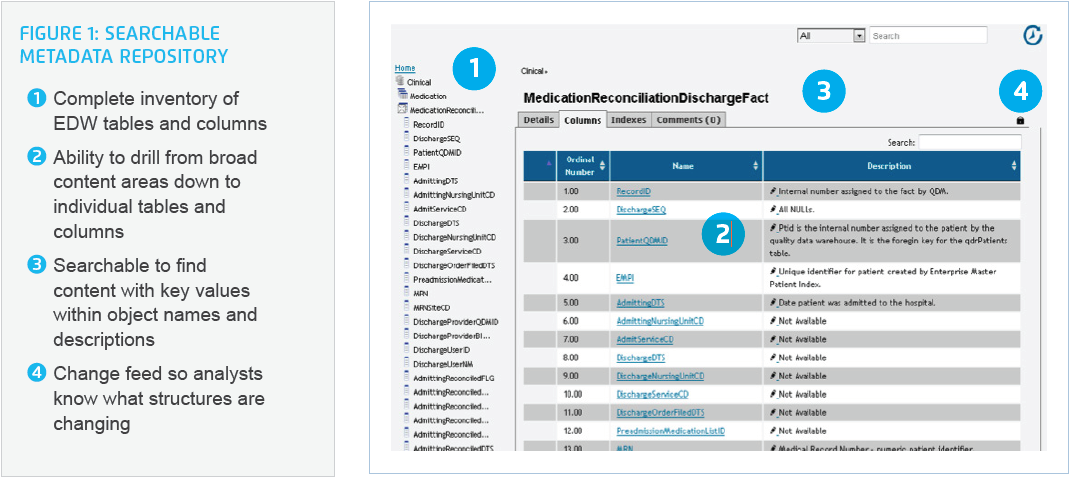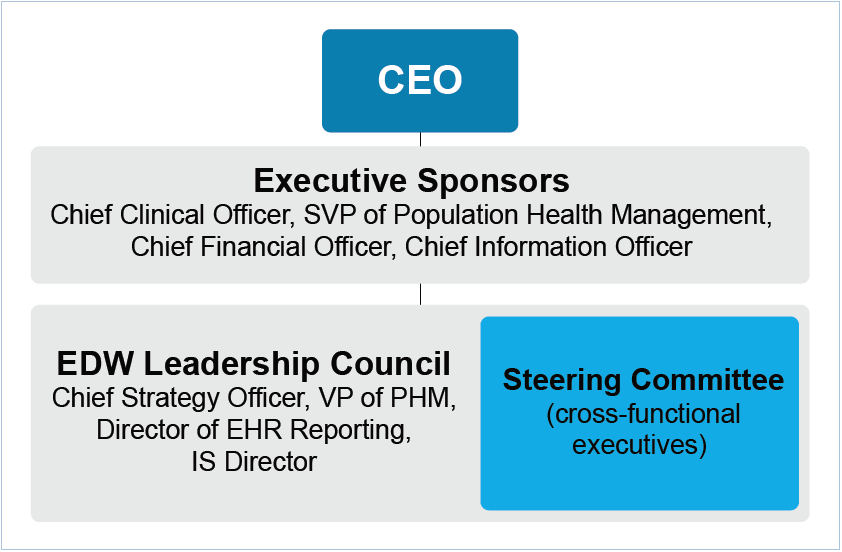The Enterprise Data Warehouse: Creating the Foundation for Effective Healthcare Improvement Analytics

- EDW now serves as the analytic foundation for Mass General Brigham’s overall value strategy
- Successfully incorporated more than 27,000 data elements from multiple disparate sources
- Established an executive governance strategy
Population health management and value-based care have arrived. In early 2015, the federal government announced official timelines for Medicare’s seismic shift from volume- to value-based reimbursement, with a goal of 50 percent by the end of 2016 and a full 85 percent by 2018.1 A consortium of the nation’s largest health care systems and private payers—The Health Care Transformation Task Force—quickly followed suit with even more aggressive timelines.2
Consortium members like Mass General Brigham are actively preparing for these new models in care and reimbursement. Founded in 1994 by Brigham and Women’s Hospital and Massachusetts General Hospital, the not-for-profit health system is committed to patient care, research, teaching, and service to local and international communities. Mass General Brigham has long recognized that increasing value and continuously improving quality are essential to maintaining excellence.
Therefore, with an eye on healthcare’s rapid evolution, Mass General Brigham has launched an advanced population health management strategy and is implementing an analytics infrastructure to support it. The strategy involves not only new technology but also a major care redesign aimed at delivering higher quality and value. The success of this important initiative hinges on integrated access to reliable data.
LACK OF INTEGRATED HEALTHCARE DATA HAMPERS PERFORMANCE IMPROVEMENT
Beginning in 2000, Mass General Brigham implemented electronic health records in its inpatient and outpatient environments to enable electronic documentation of clinical information by care providers. Quickly recognizing the value of the rich data stores that resulted, Mass General Brigham also implemented data warehouses to enable quality and cost analysis.
Whereas Mass General Brigham had no shortage of information to analyze for improvement insights, accessing it was another matter. Data was fragmented among three data warehouses—for financial, claims, and clinical data—as well as other smaller repositories. Each had been built for a targeted purpose, audience, and content area, and access and support were handled by separate teams. Adding to this complexity, each used different data identifiers and definitions. Patient identifiers, for instance, varied across the systems, and hierarchies and clinical definitions to group patients also differed. This situation created obvious challenges for analysts tasked with integrating the data into single composite views and for end users who needed to interpret it. It became clear that the analytic needs of the dynamically changing healthcare environment were not going to be met with data distributed across environments.
In the absence of easily integrated views, Mass General Brigham relied on manual workarounds that could take as long as two months to implement. This was an unsustainable approach that also fell short of delivering the level of insight Mass General Brigham wanted. In just one example, Mass General Brigham embarked on a number of efforts to understand and improve the care of patients through care redesign. Despite months of work, the improvement team was unable to achieve an adequate view of integrated data to support an effective improvement initiative. The amount of effort to collect and gather data prevented analysts from truly delivering the quality and quantity of analytic findings these groups would have benefited from.
A CULTURAL TRANSITION TO CONTINUOUS IMPROVEMENT AND LEARNING
As continuous cost and quality improvement throughout the system became essential to survival in an increasingly value-based industry, Mass General Brigham recognized a clear need to shift to a data-driven decision-making culture, especially among clinicians. This shift would require a readily accessible and trustworthy source of integrated analytic information—a common, shared analytic platform.
Importantly, Mass General Brigham wanted to implement this capability in a way that harnessed the deep experience and knowledge of healthcare data warehousing it already possessed. It was important not to simply create another data warehouse, but rather to port the existing warehouses to a shared platform and, in the end, have the same resources previously supporting separate warehouses now working on advancing analytic capabilities on a common platform.
In creating a common platform, it was also important to Mass General Brigham to maintain its analytic agility, and in some cases autonomy, knowing the diverse needs and priorities across its corporate departments and member institutions. To this end, the health system required an advanced analytic system that supported “self-service” analytics, which means that clinicians and other users with varying data technology skills could perform their own analytics rather than rely heavily on a centralized team of analysts and IT professionals.
A COMMON, SHARED ANALYTIC PLATFORM
Mass General Brigham created a foundation for success by establishing a robust, data-rich analytic environment consisting of four principal components:
A single repository of clinical, operational, financial, and claims data. This repository—an enterprise data warehouse (EDW) platform—aggregates data from different source systems to create a consistent view of data collected across the system. This is the technology foundation that supports Mass General Brigham’s transition to a data-driven culture and enables informed decision making and performance analysis.
The platform delivers intuitive tools that enable Mass General Brigham’s data architects and business intelligence teams to expand and manage the EDW in a self-sufficient manner. Tools include rapid data acquisition with automated upload of common source-system fields, schemas, data types, columns, and more. User-friendly metadata definitions and efficient data-mart design are also hallmark features of the platform’s self-service model for advanced analytics (Figure 1).
Tools to manage and query the data. Mass General Brigham implemented tools for advanced data access, analysis, and presentation to facilitate use of the data among non-technical personnel. In addition, Mass General Brigham allows local departments to also use additional tools in cases where the team may have another preferred tool.
Support services. Designed to drive engagement and help users both understand the data and master the EDW’s different tools, support services played an essential role in the initiative.

Governance. Mass General Brigham implemented a governance structure to provide overall executive guidance on priorities, access, and ensuring effective project execution. This structure was based on three components (Figure 2). The executive sponsors hold ultimate accountability for the project and provide strong leadership guidance and make prioritization decisions. The leadership council oversees day-to-day management of the project and is supported by the steering committee—a large advisory group composed of key stakeholder groups that functions as a sounding board for ideas.

RESULTS
Delivered an integrated clinical, financial, and operational analytic platform. The EDW now serves as the analytic foundation for Mass General Brigham’s overall value strategy. This core technology generates strategic information for informed decisions across the organization.
In implementing the EDW, Mass General Brigham achieved a successful transition to an integrated platform that better meets the analytic needs facing Mass General Brigham with a high degree of end-user adoption and growing satisfaction. Mass General Brigham migrated data from three standalone data warehouses, and added additional data sources previously unavailable to create the EDW. Once this platform was in place, the team implemented a variety of intuitive and powerful data analytic and presentation tools that made EDW data consumable for more end users. Support services—including a robust outreach program that ensures ongoing familiarity with available analytics applications—are now in place to help end users appreciate advanced analytics and understand how to use the applications.
Rapid implementation of the EDW made it possible to realize outcomes valuable to end users within months of implementation. Foremost among them, users can now identify new insights without requiring the weeks and sometimes months of effort previously.
Successfully incorporated more than 27,000 data elements from multiple disparate sources. These elements were sourced from EHRs and various clinical and financial systems, as well as payer, EMPI, and other external sources.
Implemented on time and on budget, harnessing its experience in data warehousing. By temporarily using consulting resources to operate the legacy warehouses to free up its own talent to work on the new EDW implementation, Mass General Brigham ensured knowledgeable resources were well placed and targeted in building new capabilities. These consulting resources are soon to be eliminated, leaving Mass General Brigham with an advanced analytics platform and an experienced team. Furthermore, the EDW has enabled valuable business intelligence and IT resources to refocus their efforts from data acquisition and reporting to analysis and process improvements.
Established an executive governance strategy. Mass General Brigham followed a project implementation approach with executive sponsorship as the centerpiece. Executive sponsors successfully prioritized projects; the leadership council delivered strong day-to-day project management and effectively removed barriers to enable rapid and continued progress; and the steering committee ensured stakeholder sponsorship and helped drive business and clinical engagement.
Mass General Brigham is using the EDW and advanced applications to better manage the enterprise and to achieve a range of objectives, including:
- More effectively identifying and matching patients and providers
- Development of advanced population health management applications
- Healthcare Directions
- Episodes of Care
- Population Insights
“With our EDW, we have not only achieved a common repository for clinical, financial, and administrative data, we have even moved beyond to develop a series of applications that enhance our population health management capabilities.”
Bill Alberghene, Data Architecture Manager
WHAT’S NEXT
Mass General Brigham continues to integrate clinical data into the EDW, a process that will be completed in tandem with the organization’s remaining EHR implementation. The health system is also expanding end-user support services to increase user skills and adoption of the EDW and data analytics. As the benefits of a single source of reliable data come into clear focus—including the development of powerful analytic applications—Mass General Brigham expects user engagement to accelerate, spurring continuous improvement across the enterprise.
REFERENCES
- Health and Human Services. (2015). Better, smarter, healthier: In historic announcement, HHS sets clear goals and timeline for shifting Medicare reimbursements from volume to value.
- Health Care Transformation Task Force. (2015). Major healthcare players unit to accelerate transformation of U.S. healthcare system.
This website stores data such as cookies to enable essential site functionality, as well as marketing, personalization, and analytics. By remaining on this website you indicate your consent. For more information please visit our Privacy Policy.